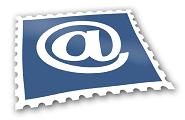Why you should send yourself a copy of your email messages.

Recently, a vendor of mine was having email problems and didn’t realize it. They were supposed to email me details about a particular service that I’d purchased, but the email never arrived. When I asked a customer service representative to re-send the email and to cc himself on the email, he replied that it wasn’t necessary to cc himself on email because “the message is right here in my outbox.” I explain that if he cc-ed himself, then we could debug the email problem. At one point, he claimed that their system had sent the message three times. I don’t doubt that he might have clicked the “send” button three times, but I do doubt that the “send” button was actually working.
I tested my email (cc-ing myself, naturally) from inside and outside of my office (for example, by sending a message from my Yahoo email account), which arrived just fine.
I filter my email for spam at both the client (with Eudora) and the server (with SpamAssassin) level. All email is delivered and suspected spam is marked as such. If your email address or domain name is on my white list, as was the case for this vendor, then your email will never be marked as spam.
I could exchange email with individuals who worked at the vendor but not with their automated system. This problem would have been very easy to debug if they simply cc-ed themselves – always.
In any event, you should always cc yourself on email messages, for a lot of reasons, including the following:
- Debugging. Messages in your email outbox (or “sent mail” folder or the like) have merely been transferred from one place on your computer to another place on your computer. If you cc yourself, on the other hand, your messages will pass through your mail server, and then you can view the full headers of the email message and see the path that the email took from the source to the destination. This can help in debugging cases where one party (like my vendor) has a broken email system but doesn’t realize it.
- Evidence. I doubt that any court would accept “it’s in my outbox” as evidence of an email’s successful transmission, but I’m pretty sure that a court (perhaps with the help of a smart expert witness) would accept a message cc-ed to yourself as evidence of transmission.
- Threading. When you have an email exchange about a particular topic, it is often helpful to review that topic in threaded (or even simply chronological order). By cc-ing yourself, you can review a full conversation in one mailbox. If your “sent” messages are in your outbox and your other messages are in your “read” mailbox, then you have to toggle between the two mailboxes to read the entire conversation. Good luck trying to unscramble those eggs.
- Proofing. How many times have you mistyped an email address? How many times have you typed “attached is the document you requested” only to realize that you never actually attached the document? When you cc yourself, it is good practice to reread the message that you just sent. You’ll notice mistyped email addresses, typos, misspellings, and omitted attachments. All of which can be quickly remedied by resending a corrected message.
- Email portability. Email that you receive is likely to be in some standardized format. Email that you sent, not so likely. So if you need to move all of your email from one email client to another, then it will be a lot earlier to move your “read” email than your “sent” email.
Since 01/01/2002, I have been cc-ing myself on all of my email. In Eudora, it’s simple to set up a stationery file to automatically cc yourself on every new message you compose. I wish that I had been doing it earlier, since I have email dating back to 1992, much of which is in my (mostly useless) “sent” mailboxes.
Oh yes, I never did get an automated message from that vendor, and I’m not likely to do business with them again.

